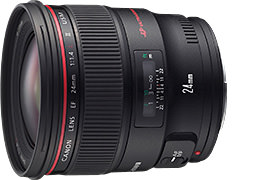Astrophotography: Capturing Clear Starry Skies with f/1.4 Lens
Astrophotography is often about how you capture the stars. In this article, let us look at the key points for capturing the starry sky using a bright lens with a maximum aperture of f/1.4. Your scope of photographic expression will widen and your photography experience can be even more enjoyable if you are able to adjust the f-number with a good understanding of its effects! (Reported by: Shigemi Numazawa)

EOS-1D X/ EF24mm f/1.4L II USM/ FL: 24mm/ Manual exposure (f/1.4, 30 sec.)/ISO 1250/ WB: Auto
Getting out of the car in the mountains and looking up into the southern sky, I found the bright Milky Way and the Scorpius risen high, both brilliantly shining in the cold air of the night. The image was captured using an f/1.4 large aperture lens. As the sky was clear, I raised the ISO setting slightly and selected a long exposure of 30 seconds, capturing the photo with the aid of equatorial mount tracking.
Create a more dramatic impression than what you actually see
Feeble lighting, stars that appear constantly moving because of the rotating Earth...In astrophotography, you encounter numerous restrictions which do not apply for daytime photography. Still, with the excellent high ISO performance of digital cameras and a bright large-diameter lens, you can capture images of the night sky vividly and in detail.
A lens with maximum aperture of about f/2.8 may be considered “large aperture”. However, where star photography is concerned, the difference in expressive capability between f/1.4 and f/2.8 or f/2.0 is greater than you might think.
To capture stars as dots from a fixed position, you need a wide-angle lens with the exposure duration set to 20 seconds or shorter. On a moonless night in the countryside, the standard ISO setting for an f/1.4 lens should be about ISO 800 to obtain an adequate exposure level for 20 seconds. On f/2 and f/2.8 lenses, this standard setting is about ISO 1600 and ISO 3200 respectively, in order to produce images that are rich in gradation with little noise.
And this is not all. An f/1.4 lens is capable of reproducing the starry sky in a way that can never be experienced with an f/2 lens. What the lens offers is not just excitement when we are standing at the scene, but also other bonuses in terms of hues, details or other elements that are beyond our expectations.
Tip 1: Use dark stars to establish focus
It is hard to find the focus peak for bright stars when you use large aperture lens of f/1.4, because such stars look larger and more saturated. To establish focus, you are therefore recommended to use a dark star. To further increase the accuracy, you can try using a few stars.
Tip 2: Fine-tune focus on the LCD screen with a magnifying lens

You certainly need to enlarge your Live View display when you try to use it to establish focus on stars, but the darkness at night will make checking difficult especially for those whose vision has deteriorated with age. A 5x magnifying lens will be an essential item in this case.
Receive the latest updates on photography news, tips and tricks by signing up with us !

Recommended f/1.4 Lens
EF24mm f/1.4L II USM
This is a lens that offers brightness essential for capturing starry skies. I have been making active use of this lens at the maximum aperture despite the coma aberration at the edges, as that can be minimised with a soft filter.
Born in Niigata in 1958, Numazawa has been active in the fields of astrophotography and astronomical painting. He was involved in many science program projects by NHK. Awarded by the Environment Minister, he is currently a National Geographic Tour photographer.

A monthly magazine that believes that enjoyment of photography will increase the more one learns about camera functions. It delivers news on the latest cameras and features and regularly introduces various photography techniques.
Published by Impress Corporation

































